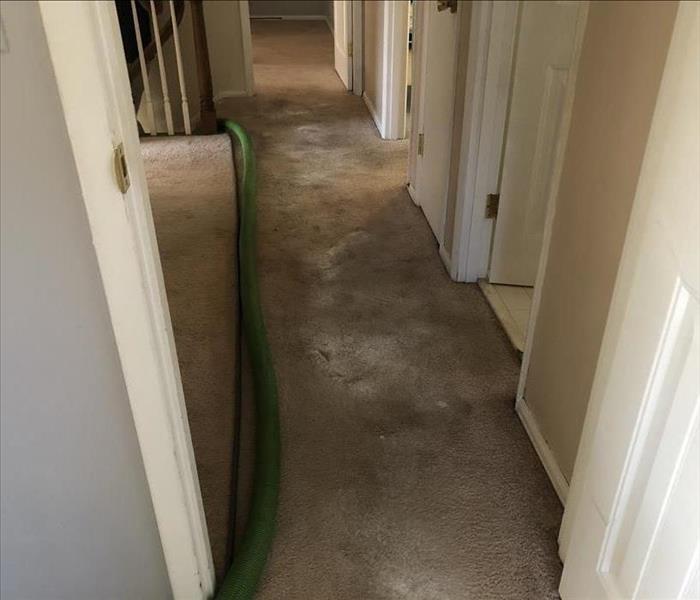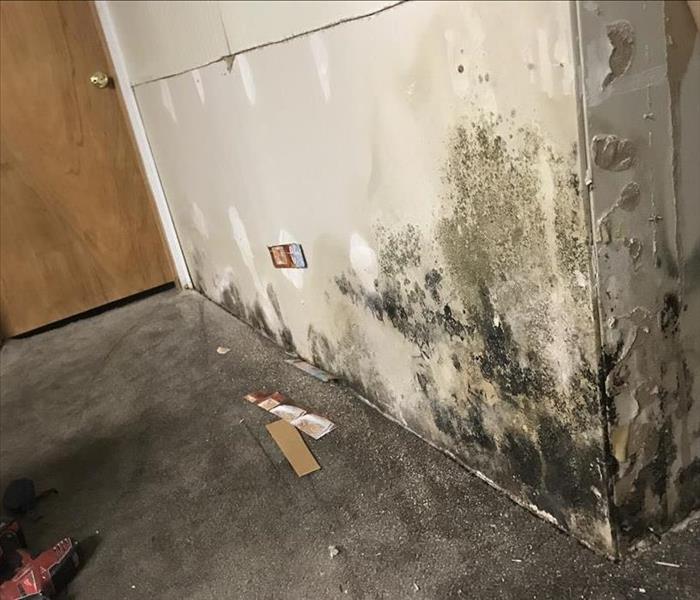Recent Mold Remediation Posts
Mold in Schools: Risks and Prevention Measures
3/13/2024 (Permalink)
 SERVPRO® working on remediating water damage.
SERVPRO® working on remediating water damage.
Mold in schools can pose challenges for both educators and students. Recognizing the risks associated with mold growth and implementing effective prevention measures are crucial for maintaining a safe and conducive learning environment. In this blog post, we'll explore the potential risks of mold in schools and provide practical prevention measures to ensure a healthy space for education.
Identifying Common Areas Prone to Mold
Certain areas within schools are more prone to mold growth due to factors like moisture, poor ventilation, and high humidity. Classrooms, cafeterias, gymnasiums, and locker rooms are common areas where mold can thrive. Regular inspections of these spaces can help identify early signs of mold and prevent its spread.
The Impact of Mold on School Infrastructure
Mold can negatively impact the infrastructure of schools, potentially leading to structural damage over time. Mold feeds on organic materials such as wood, drywall, and insulation. Prolonged exposure to mold can weaken these materials, compromising the structural integrity of the school building. It's crucial to address mold issues promptly to prevent further damage and ensure a safe learning environment.
Moisture Control in Schools
Controlling moisture is a fundamental step in preventing mold growth in schools. Schools should implement measures to address water leaks promptly, ensure proper ventilation in all areas, and use dehumidifiers where necessary. By controlling moisture levels, schools create an environment that is less conducive to mold growth and minimize the risks associated with mold.
Regular Inspections and Maintenance
Regular inspections and maintenance routines are essential for identifying and addressing potential mold issues in schools. School administrators and facility managers should conduct routine checks for signs of water damage, leaks, or areas with poor ventilation. Timely maintenance can prevent mold growth from escalating and contribute to a healthier learning environment.
Professional Mold Assessment and Remediation
If mold is detected in a school, it's crucial to enlist the services of professionals for mold assessment and remediation. Certified experts, like SERVPRO®, can assess the extent of the mold damage, develop a comprehensive remediation plan, and restore the affected areas to a safe condition. Professional mold remediation ensures thorough and effective removal of mold, preventing its recurrence.
Proper Ventilation Systems
Proper ventilation is key to preventing mold growth in schools. Ensure that ventilation systems are functioning optimally in classrooms, gyms, and other shared spaces. Regularly clean and maintain ventilation systems to improve air circulation and reduce humidity levels, creating an environment that is less favorable for mold growth.
Encouraging Good Housekeeping Practices
Promoting good housekeeping practices among school staff and students can contribute to mold prevention. Encourage regular cleaning of classrooms, common areas, and storage spaces. Emphasize the importance of promptly reporting any signs of water damage or leaks to facilitate swift intervention.
Timely Addressing of Water Intrusion
Water intrusion is a primary contributor to mold growth in schools. Whether it's a leaky roof, plumbing issue, or foundation concern, address water intrusion immediately. Identify and fix the source of the problem to prevent ongoing moisture buildup and safeguard the school's infrastructure from potential damage.
Understanding the risks associated with mold in schools and implementing effective prevention measures is crucial for creating a safe and healthy learning environment. By addressing moisture control, conducting regular inspections, and enlisting professional mold remediation services when needed, schools can ensure the longevity of their infrastructure and prioritize the well-being of students and staff. Trust SERVPRO® to be your partner in addressing mold-related concerns and maintaining a conducive environment for education.
How to Prevent Mold Growth in Schools
11/8/2023 (Permalink)
 Mold growth in schools is a significant concern that can impact the structural integrity of the building and the well-being of those inside.
Mold growth in schools is a significant concern that can impact the structural integrity of the building and the well-being of those inside.
Mold growth is a significant concern that can impact the structural integrity of educational facilities and the well-being of those inside. In this blog, we will explore the risks associated with mold in schools and provide valuable prevention measures to help keep our schools mold-free.
The Risks of Mold in Schools
Weakening of Materials
Mold thrives in damp and humid environments, and when it takes root within building materials like drywall, wood, and insulation, it gradually weakens them. Over time, this can lead to significant structural issues that are not only costly to repair but can also compromise the safety of the building.
Compromised Integrity
Drywall, which is commonly used for walls and ceilings in schools, is particularly susceptible to mold infestations. Mold can break down the cellulose within the drywall, causing it to become soft and crumble. This not only poses a safety risk but can also result in unsightly holes and damage that require extensive repairs.
Musty Odor
One of the most noticeable signs of mold in schools is the musty and unpleasant odor it emits. This odor can permeate classrooms, hallways, and common areas, creating an uncomfortable and distracting learning environment for students and staff alike. The persistent smell can be particularly disruptive during lessons and activities.
Potential for Disruption
Dealing with mold issues can disrupt the regular operations of the school. Mold remediation efforts may require sections of the building to be temporarily closed off, affecting classroom availability and educational continuity. This disruption can be both logistically challenging and a source of frustration for everyone involved.
Preventing Mold Growth in Schools
- Regular Inspections: Establish a routine inspection schedule to identify potential areas of moisture and mold growth. Pay close attention to areas with inadequate ventilation, such as basements, attics, and bathrooms.
- Effective Moisture Control: Preventing moisture buildup is essential for mold prevention. Promptly address any leaks, roof damage, or plumbing issues. Ensure proper drainage around the school building.
- Proper Ventilation: Promote good air circulation and reduce humidity levels by maintaining adequate ventilation throughout the school. Consider using dehumidifiers in areas prone to excess moisture.
- Educate Staff and Students: Raise awareness about mold prevention among staff and students. Encourage them to report any signs of water damage or mold growth promptly.
- Cleaning and Maintenance: Regularly clean and maintain HVAC systems, as they can harbor mold if not properly cared for. Clean and disinfect surfaces prone to moisture, like sinks and bathroom fixtures.
- Professional Assistance: If you suspect mold growth, it's crucial to seek professional help. SERVPRO® of Monroe, Randolph & Washington Counties, offers mold remediation services to safely and effectively remove mold from your school premises.
Mold growth in schools is a significant concern that can impact the structural integrity of the building and the well-being of those inside. By taking proactive measures and implementing proper prevention strategies, schools in the Waterloo, IL, area can maintain a safe and conducive learning environment. If you need assistance with mold remediation or have concerns about mold in your school, SERVPRO® is here to help. Contact us today for expert assistance in keeping your school mold-free and conducive to learning.
Containment 101: How to Properly Contain Mold During Remediation
5/21/2023 (Permalink)
Mold remediation is the process of removing mold from a building or home. During mold remediation, it is crucial to contain the mold to prevent it from spreading further. If mold is not contained properly, it can cause serious problems for the occupants and lead to more extensive damage to the building. In this blog, we will discuss how mold is contained during remediation.
Establish Containment Area
The first step in containing mold during remediation is to establish a containment area. This can be done using plastic sheeting or other materials to create a sealed area where the mold removal will take place. The containment area should be large enough to accommodate the workers, their equipment, and any debris that will be removed.
Negative Air Pressure
Once the containment area has been established, negative air pressure should be created. Negative air pressure means that air is being sucked out of the containment area, which prevents mold spores from escaping into other areas of the building. This is achieved using a HEPA (High-Efficiency Particulate Air) filter that is placed inside the containment area and connected to an air duct that leads outside.
Seal Off HVAC System
The HVAC (Heating, Ventilation, and Air Conditioning) system should be sealed off to prevent mold spores from spreading through the ductwork. This can be done by blocking off the vents and covering the air intake with plastic sheeting.
Use Personal Protective Equipment
During mold remediation, workers should wear personal protective equipment (PPE) to protect themselves from exposure to mold spores. This includes respirators, gloves, eye protection, and protective clothing.
Clean Containment Area
Once the mold removal is complete, the containment area should be thoroughly cleaned using a HEPA vacuum and damp cloths. The plastic sheeting should then be removed and disposed of properly.
In conclusion, containing mold during remediation is crucial to prevent it from spreading further and causing problems or additional damage to the building. Establishing a containment area, creating negative air pressure, sealing off the HVAC system, using PPE, wetting and bagging materials, and cleaning the containment area are all essential steps in containing mold during remediation. By following these procedures, mold can be safely and effectively removed from the building.

 24/7 Emergency Service
24/7 Emergency Service